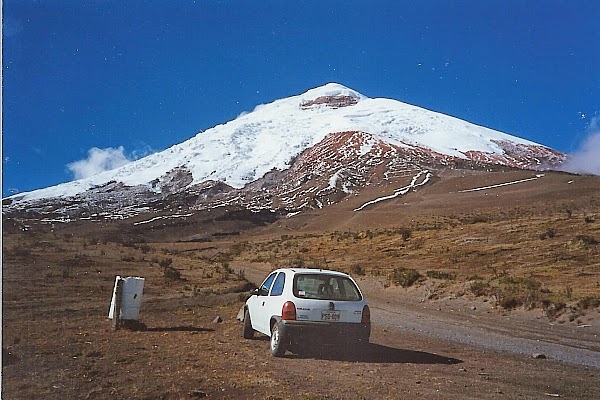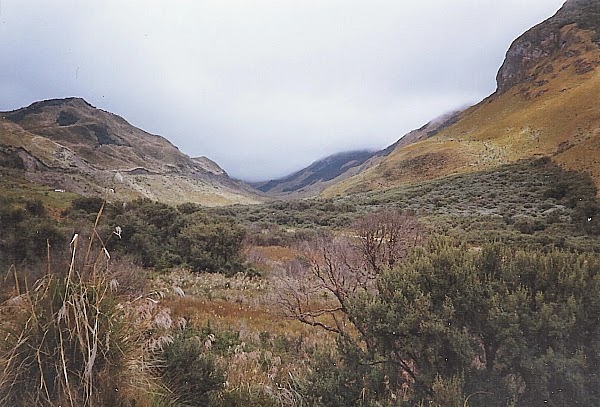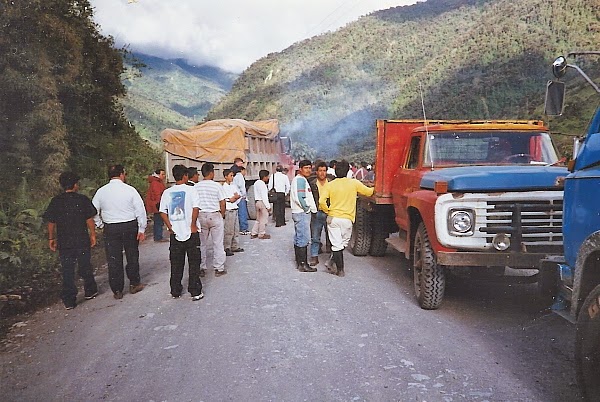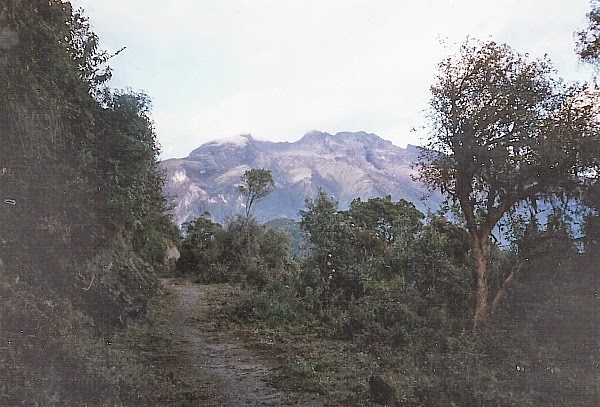This is the final part of a blog recounting a trip to Ecuador in 1999 with Michael Grunwell. I only had a pocket camera so no bird photos were taken. The views have somewhat degraded too.
Cotopaxi (2-3 September). Back in Quito we picked up a car and headed
south to Cotopaxi, arriving early afternoon. We headed straight up to look for
Rufous-bellied Seedsnipe but were caused some initial problems as the green
bins we’d been told to look out for had been painted white! We wandered around and eventually found a pair
on the more barren slopes a couple of kms below the upper car-park, very nice. Most of the other birds were around Laguna de
Limpiopungo and it was nice to see Tanwy Antpitta again in the nearby scrub,
although I only encountered three. On my
previous visit to Cotopaxi (in summer 1986) we’d slept in one of the refugios
close to the laguna. They were in
considerable disrepair, making that no longer an option so we slept in the car
nearby and were glad to have decent sleeping bags. The following morning was spent birding the
same general areas and seeing similar birds (including another pair of
seedsnipe). We then left to drive to
Papallacta.
Birds
seen included Andean Teal, Yellow-billed
Pintail, Puna Hawk, Carunculated Caracara, Andean Coot, Rufous-bellied
Seedsnipe, Greater Yellowlegs, Spotted Sandpiper, Baird’s Sandpiper, Noble
Snipe, Andean Lapwing, Andean Gull, Black-winged Ground Dove, Ecuadorian
Hillstar, Black-tailed Trainbearer, Stout-billed and Bar-winged Cinclodes,
Streak-backed Canastero, Tawny Antpitta, Tufted Tit-Tyrant, Brown-backed
Chat-Tyrant, 3 species of Ground-Tyrant, Great Thrush, Grass Wren, Plumbeous
Sierra-Finch and Tricoloured Brush-Finch.
 |
| Rufous-bellied Seedsnipe habitat |
 |
| Cotopaxi emerging from the clouds |
 |
 |
 |
| our car and a (formerly) green bin |
Papallacta Pass, Cabanas San
Isidro & Huacamayos Ridge (3-6 September). We arrived at Papallacta at lunch time and
stopped in a few places before and after the summit. The weather was not very good and few birds
were in evidence so we decided to continue and try some sites on the way to
Baeza. About halfway there we found the
road to be blocked while a van was recovered from having crashed down a steep
slope. This took over 2 hours and we did
not get going again until just before dusk.
We arrived in Baeza early evening, having initially missed the turning
in the dark. We stayed in the pleasant,
but basic, Hotel Samay, making it our base for 3 nights.
Birds seen on
Papallacta included Black-chested Eagle, Puna Hawk,
Carunculated Caracara, Upland Sandpiper, Shining Sunbeam, Mountain Velvetbreast,
Viridian Metaltail, Blue-mantled Thornbill, Rainbow-bearded Thornbill,
Bar-bellied Woodpecker, Stout-billed and Bar-winged Cinclodes, White-chinned
Thistletail, Pearled Treerunner, Tawny Antpitta, Brown-backed Chat-Tyrant,
Red-rumped Bush-Tyrant, Green Jay, Great Thrush, White-capped Dipper, Rufous
Wren, Spectacled Whitestart, Black-crested Warbler, Buff-breasted
Mountain-Tanager, Black-backed Bush-Tanager, Superciliaried Hemispingus,
Southern Yellow Grosbeak, Plumbeous Sierra-Finch, Pale-naped Brush-Finch
 |
| the Papallacta road |
 |
| approaching the pass |
 |
| one of many unsuccessful stops on the way down to check for Torrent Ducks and White-capped Dippers |
 |
| the road was temporarily closed while a crashed vehicle was winched up from below |
We left
Baeza just before dawn, driving to Cabanas San Isidro in about an hour. The main Tena road was very muddy in places
and the track up to San Isidro even more so, although we managed in our saloon
car (with one or two anxious moments).
The state of the road made us reluctant to travel far in the dark so we
left San Isidro for the main road before dusk.
Scanning the main river at regular intervals each day produced one male
Torrent Duck on one occasion. It is
possible, but very expensive, to stay at Cabanas San Isidro. We had arranged to use the trails for $10 per
person per day. This too seemed very
expensive as the trails were badly in need of maintenance (the famous log trail
being under at least 6 inches of mud in several places). Our impressions of Cabanas San Isidro were
not helped by seeing practically no birds of interest during our day there
(probably not helped by a malfunctioning microphone and almost continual heavy
rain in the morning). Our intention to
spend four days in the area was soon put to the test and after a birdless
morning at Huacamayos Ridge (in perfect weather) and an afternoon dodging heavy
showers along the dirt road past San Isidro (where we actually saw more birds
than at san Isidro itself) we decided to head back to the west slope. This area was the biggest disappointment of
the trip, although perhaps we should have persevered, but in the event our
leaving the area early was to be the best decision of the trip.
On our return on 6th
we left Baeza at dawn and stopped a number of times on the way up to Papallacta
checking for dippers before finally seeing a pair under a large metal bridge
which took the road over a large tributary.
A stop in Papallacta village failed to produce any Sword-billed
Hummingbirds on the numerous datura flowers and a stop just outside town for
Mountain Avocetbill was equally unsuccessful.
We then walked sections of the road up to the pass, in equally indifferent
weather to that experienced on our earlier visit. The pass itself was covered in cloud and we
quickly returned to Quito and the west slope.
Birds
seen at San Isidro and Huacamayos Ridge included Torrent Duck, White-throated
Quail Dove (on log trail), Speckle-faced Parrot, Scaly-naped Amazon,
White-collared Swift (35 that zoomed over Huacamayos Ridge were almost the best
thing seen in the area!), Crested and Golden-headed Quetzals, Highland Motmot,
Emerald Toucanet, Crimson-mantled, Yellow-vented and Powerful Woodpeckers,
Azara’s and Rufous Spinetails, Long-tailed Antbird, Sulphur-bellied Tyrannulet,
Rufous-crowned Tody-Tyrant, Handsome Flycatcher, Smoky Bush-Tyrant, Pale-edged
Flycatcher, Green and Black Fruiteater, Green Jay, Black-billed Peppershrike,
Mountain and Grey-breasted Wood-Wrens, Slate-throated and Spectacled
Whitestart, Three-striped, Black-crested and Russet-crowned Warblers, Grass-green,
Saffron-crowned, Flame-faced, Golden-naped and Beryl-spangled Tanagers,
Lacrimose, Blue-winged and Hooded Mountain-Tanagers, Black-eared Hemispingus,
Chestnut-capped Brush-Finch, Russet-backed Oropendola, Mountain Cacique and
Olivaceous Siskin.
 |
| near San Isidro |
 |
| view from Huacamayos Ridge |
Mindo Lindo (6-7 September). We put our disappointment
with San Isidro to good use by returning to the west slope. We arrived at Mindo Lindo from Papallacta
early afternoon, were immediately made welcome by Pedro (who knew slightly more
English than we did Spanish) and taken to the Club-winged Manakin lek, being
shown a female Long-wattled Umbrellabird (which had been in residence for just
over a week) on the way. Three hours in
the area of the lek only produced a female but this too worked to our advantage
(not that it seemed like it at the time) as we decided to stay overnight and
try to see a male manakin in the morning.
Pedro and Helke let us stay in a nice cabin they occasionally rent out
and we were invited up for supper and made to feel a part of the family by
them. The next morning, before an
excellent breakfast, we had excellent views of four male manakins lekking
(birds of the trip) and saw a male Scaled Fruiteater. Soon after we found a roosting Pigmy Owl
which was being mobbed by tanagers which, I’m told, ‘must have been’ the newly
described Cloud-forest Pigmy Owl!
Despite covering only a small area (we were never more than 10 minutes
walk from the house) we thoroughly enjoyed our time there and in many ways
Mindo Lindo was the highlight of the trip.
Birds
seen included Red-billed Parrot, Cloud Forest Pigmy Owl, Tawny-bellied Hermit,
Green-crowned Woodnymph, Fawn-breasted Brilliant, Brown Inca, Booted
Racket-tail, Golden-headed Quetzal, Masked Trogon, Red-headed Barbet, Azara’s and
Red-faced Spinetails, Strong-billed Woodcreeper, Scaled Fruiteater, Long-wattled
Umbrellabird, Club-winged Manakin, Grey-breasted Wood-Wren, Tropical Parula, Rufous-throated,
Golden, Golden-naped and Beryl-spangled Tanagers and Tricoloured and
Chestnut-capped Brush-Finches.
Los Bancos Road (7 September). We returned to the Los
Bancos Road for another couple of hours on 7 September, arriving mid-morning.
The weather wasn’t as good as for our previous visit, with periods of rain, but
the area produced some quite different birds.
We then returned to Mindo for lunch, stopped briefly at the new hotel
track (but saw little there) and returned to Quito for our last night. We had the car until the morning but Michael
wanted a good night’s sleep before our journey home as he was going straight
into work off the flight. I was less
bothered about that, and keen to save the cost, so I dropped Michael off on the
outskirts of Quito. After seeing him
into a taxi I drove up to Yanacocha, arriving just before dusk.
Birds
seen on the Los Bancos road inluded Spectacled Foliage-gleaner, Pale-vented and
Ecuadorian Thrushes, Tropical Parula, Russet-crowned Warbler and Glistening-green,
Blue-necked, Silver-throated, Flame-faced, Blue-necked, Bay-headed and
Moss-backed Tanagers.
Yanacocha (7-8 September). I revisited Yanacocha for my last morning
(Michael having returned to Quito for a good night’s sleep as he was going into
work straight from the airport when we got back). I managed to find my way to Yanacocha with no
problems, arriving in thick cloud with about an hour of light left. I saw little in this time and had a
reasonable night in the car just inside the compound, having first checked with
the watchman there that it was OK to do so.
The following morning I saw a couple of the birds we hadn’t found on the
earlier visit (but no more tapaculos).
Some impressive activity from the nearby Volcan Pichincha provided a
memorable finish to the trip.
Birds
seen included Carunculated Caracara, Short-eared Owl, Mountain Velvetbreast,
Great Sapphirewing, Buff-winged Starfrontlet, Sapphire-vented Puffleg,
Golden-breasted Puffleg, Black-tailed Trainbearer, Purple-backed Thornbill, Tyrian
Metaltail, Tawny Antpitta, Red-crested Cotinga, Barred Fruiteater, Great Thrush,
Rufous Wren, Black-chested Mountain-Tanager, Superciliaried Hemispingus and
Tricoloured Brush-Finch.
 |
| the service track at Yanacocha made for relatively easy birding |
 |
| Volcan Pinchincha started to let off sulphur-smelling clouds |
 |
 |
| a very memorable end to an enjoyable trip |
Thanks to Michael for
his company during the trip, Tom Love for his while we were at Bellavista, Tony
Nunnery and Iain Campbell for sharing time in the field (and floor space) with
me and particularly Helke and Pedro for making us so welcome at Mindo Lindo. By not going to the Galapagos the trip cost
me about £1000 including airfares from England.
[blogged December 2014]
























No comments:
Post a Comment
Note: only a member of this blog may post a comment.